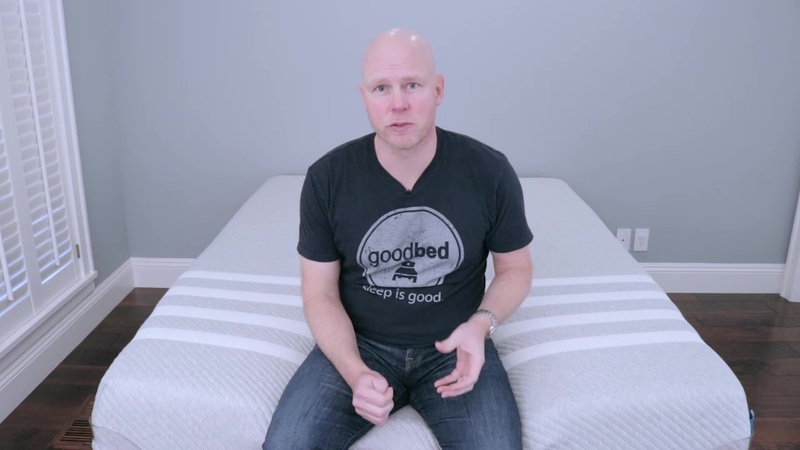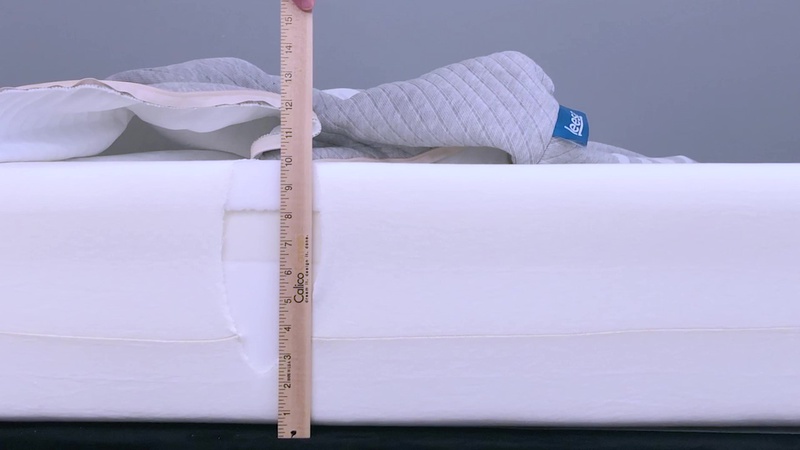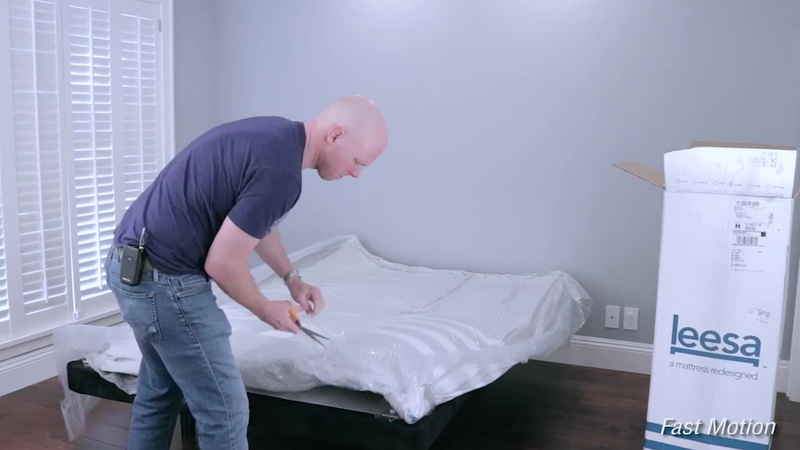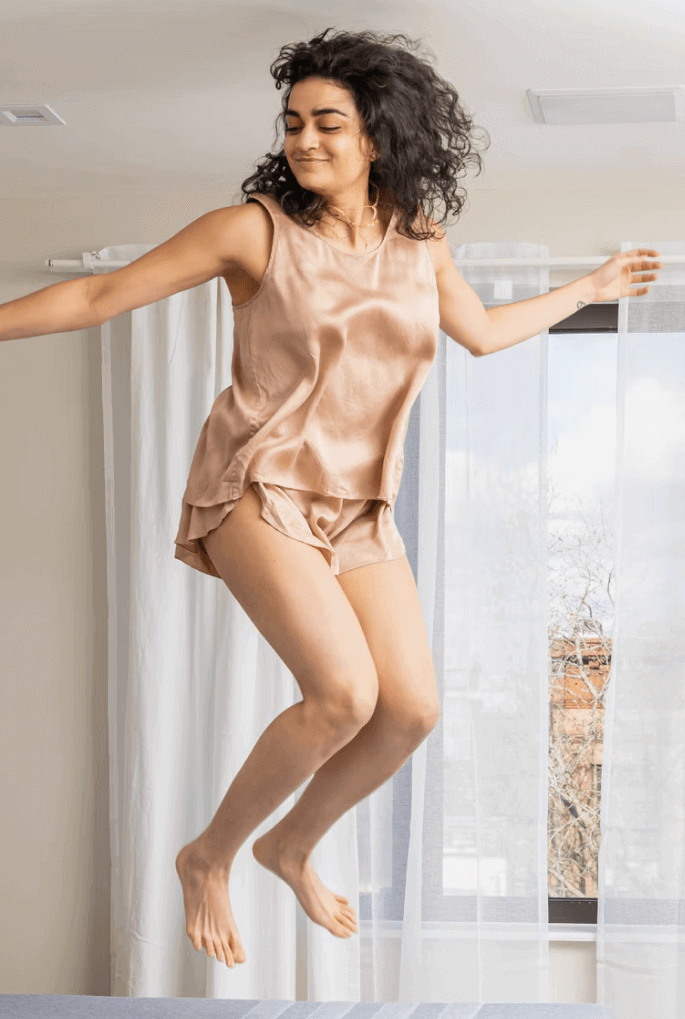The foam layers of the Leesa are wrapped in a fire sock (required by law as a flame retardant) and enclosed in a zippered cover (on three sides). The cover is relatively flat and doesn’t add much extra loft to the bed. We tugged and twisted the cover and felt sturdy and well made. It felt to us like a thick and comfy sweatshirt material.

Comfort & Feel
There are three aspects that make up our assessment of comfort and feel. We call these "preference-based characteristics" because no rating here is better or worse – rather, the attributes that are most desirable to you will be determined solely by your personal preferences. We apply the same classification standards to each mattress so you can more easily compare apples to apples.
Softness ( what’s this )
Keep in mind that what mattress companies call “firm” or “soft” is a purely a preference. All mattresses should be supportive and promote healthy spinal alignment. Whether a mattress is fluffy and squishy (what mattress companies call soft or plush), or less so (what companies call firm), is purely down to your personal needs and preferences.
We classify the Leesa mattress as a Medium Firm mattress, with more of a floating on top feeling than sinking deeply.
Not sure what softness is best for you? Take our Mattress Match Quiz and find out.
| Softness Level (1=Least Soft, 9=Most Soft) |
4 | Medium Firm |
Cushioning Depth ( what’s this )
This refers to how deeply you sink into the mattress or feel cradled or hugged by your mattress; how far you sink into it. For our tester the Leesa mattress had shallower cushioning than average. While you sink a bit, it’s certainly not enough to feel enclosed or snuggled.
| Cushioning Depth (1=Shallowest, 9=Deepest) |
4 | Slightly shallower than average |

Responsiveness ( what’s this )
Responsiveness refers to how quickly a mattress recovers its shape after being compressed. When you press your hand into the mattress, for instance, then remove it, does it take several seconds for the mattress to return to flat, or does it recover immediately?
While the Leesa mattress does have a 2” layer of memory foam (the second layer of the mattress), it really does not have much of that recognizable memory-foam feel, where after compressed, your hand print takes several seconds to disappear (some describe this as a slow, melting into the mattress feeling). When we pressed down hard into the mattress, we could see a slight bit of the memory foam effect from that second foam layer.
Responsiveness also translates to bounce. While we noticed a little bit of surface bounce because of the tight cover, there's no deep bounce. When our tester dropped his weight on to the bed, he didn't bounce at all. If you’re a fan of a bouncy mattress, foam beds in general might not be right for you.
| Memory Feel (1=Least, 9=Most) |
3 | A little memory feel |
| Bounce (1=Least, 9=Most) |
4 | A little bounce |
Back Support & Pressure Relief
The two things that you should always be sure to get from your mattress are spinal alignment (commonly thought of as "back support") and pressure relief. Unfortunately, no mattress will deliver these two things equally well for all sleepers. In particular, spinal alignment and pressure relief capabilities will vary across sleepers with different weights, body shapes, and sleep positions. To help you determine how this mattress will perform for you, we break down our spinal alignment and pressure relief assessments by sleeper type.
In our evaluations, the Leesa mattress afforded very good back support and spinal alignment, particularly for back and side sleepers.
Spinal Alignment
The key to good back support is maintaining proper spinal alignment while you sleep. This means that the mattress should hold your spine in roughly the same position it's in when you're standing. The ability of a given mattress to do this will generally depend on your weight, sleep position, and body shape.
Here is how we break down the spinal alignment of the Leesa mattress:
| Weight | Range | Back Sleepers | Side Sleepers | Stomach Sleepers |
| Lighter | <150 lb | 9 | 6 | 9 |
| Average | 150 to 200 lb | 9 | 7 | 9 |
| Above Average | 200 to 250 lb | 9 | 7 | 8 |
| Heavier | >250 lb | 8 | 8 | 7 |
Back Sleepers:
While our tester was on his back, he noted that his hips sank just deeply enough to create a very neutral spine, while he felt the mattress did a nice job reaching up to support his lumbar curve. We feel that sleepers of a wide weight range would have a similar experience, with the possible exception of those significantly heavier than our tester, maybe more than 250 lbs., who might sink through the four inches of softer foam to rest on the harder support foam below.
Side Sleepers:
The Leesa mattress was fine for our tester in the side-sleeping position. He would have liked his shoulder to sink more deeply into the bed. And for those lighter or curvier than our tester, it might be even harder for shoulder to sink enough into the Leesa to create a neutral spinal alignment. We thought it would be fine, however, for side sleepers heavier than our tester.
Stomach Sleepers:
Achieving good spinal alignment for stomach sleepers can often be trickier as the hips can tend to sink down too far with some mattresses, but our tester felt well supported in this position as well. We did have concerns, as we do with many all-foam beds, that heavier (250+ lbs.) stomach sleepers could sink too deeply into the bed, which can lead to an over-arched back, which in turn could lead to back pain.
Pressure Relief
When a mattress pushes back against your body with too much force in a concentrated area, the result can be pain, soreness, loss of circulation, excessive tossing, and other problems. In general, such "pressure points" are of greatest concern for side sleepers, since that's the position in which your body's weight is distributed over the smallest surface area. To find the right mattress for your needs, keep in mind that the pressure-relieving capabilities of any given mattress will vary depending on the sleeper. Factors like your weight and body shape (e.g., broader shoulders and/or hips) will determine how far you sink into the mattress, and the pressure relief offered by that mattress will vary widely at different depths.
Here's how we sized up the pressure relief of the Leesa mattress:
| Weight | Range | Typical Curves | Extra Curvy |
| Lighter | <150 lb | 6 | 6 |
| Average | 150 to 200 lb | 7 | 6 |
| Above Average | 200 to 250 lb | 7 | 6 |
| Heavier | >250 lb | 7 | 6 |
Overall, we found the pressure relief offered by the Leesa mattress to be good. Our tester didn’t experience any specific issues, and he didn’t feel that he ‘bottomed out’ or pushed through the mattress’s comfort layers and into the firmer support foam layer. However, we do wonder about heavier or curvier people, whose hips and shoulders could possibly sink through those top layers to the harder support layers of foam. And as with side sleeping, we wondered if lighter people might not be heavy enough to depress the foam enough to find good pressure relief. For most people in an average size range, we thought pressure relief was adequate.
While our tester didn’t experience any pain or serious issues, if pressure relief is a major concern for you, there are other mattresses that do a better job.

Other Features
Beyond the preference-based characteristics of comfort and feel, and the body matching for spinal alignment and pressure relief, a mattress will have a number of other attributes that can make it a better or worse choice for you. We call these "priority-based characteristics" because they are areas in which a mattress can be better or worse, but that will have differing amounts of importance to each sleeper. So, determining how much importance to give to these features will be entirely a matter of your own personal priorities. As always, we apply the same ratings standards to each mattress so you can more easily compare apples to apples.
Motion Isolation ( what’s this )
With a bowling pin standing upright on the Leesa bed, we tested motion isolation first by applying manual pressure (our tester pushed into the mattress with his arm), then by our tester dropping his weight onto the bed. We did notice some movement transfer when pressing on the mattress, mainly when the cover moved and pulled the pin with it.
But when our tester dropped his weight to the bed, there was almost no movement from our bowling pin, which leads us to conclude that the Leesa mattress would be a very good choice for those sensitive to a partner’s movements in bed.
| Motion Isolation Rating |
8/10 | Very good |
Temperature ( what’s this )
For most people, we do not think the Leesa mattress will feel hot. Memory foam has a reputation for heat retention, but in the case of the Leesa bed, the memory foam layer is not on top. And because this is not a deeply cushioned bed, more of your body is exposed to the air.
If overheating in bed is an issue for you, and you’ve experienced it with other mattresses, you might want to explore other models, or consider going with an innerspring mattress, but for a foam mattress, we don’t think the Leesa bed will feel hot to the majority of people.
| Stays "Cool" Rating |
5 /10 | Okay |
Edge Support ( what’s this )
Foam mattresses aren’t typically very supportive along the very edge of the mattress—important if you like to sit on the edge of the bed, or if you tend to sleep along the edge. With the Leesa mattress, our tester did experience a substantial amount of dip when sitting on the edge of the mattress, but he did feel stable.
When laying on the very edge of the mattress, our tester also felt stable, and didn’t feel he was slipping or leaning at all. Especially for a foam mattress, the Leesa had very good edge support despite not having any specifically designed features to address this issue.
| Edge Support Rating | 7 /10 | Good |

Ease of Repositioning ( what’s this )
One of the highlights of the Leesa mattress, for our tester, was ease of movement. Mattresses with memory foam don’t have the best reputation when it comes to how easy it is to roll into different positions. However, the memory foam in the Leesa bed is two inches down, and the top Avena layer is a very responsive foam we felt had many behavioral qualities of latex. Our tester felt that changing positions was very easy. An all-natural latex bed might be even better.
| Repositioning Rating |
9 /10 | Excellent |
Green Features ( what’s this )
For mattress shoppers concerned with the use of natural materials, sustainable manufacturing practices or the like, we offer our subjective evaluation of any efforts taken by the company to make the mattress more green, healthy, or safe.
In the case of the Leesa mattress, the company makes no claims about the use of natural materials; its foams are petroleum-based.
All of the foams used are certified to the CertiPUR-US standard, which verifies that a material has low VOC off-gassing as well as a lack of chemicals and other substances regulated by the CPSC. This certification is the standard among mattresses containing foam.
The company does have some publicly-stated social initiatives. For every 10 mattresses sold, Leesa donates one mattress to charity. The company says that it has donated more than 32,000 mattresses so far to disaster recovery, homeless and women’s shelters, and Habitat for Humanity. Read more about Leesa's social initiatives on its website.
The company also says it plants a tree for each mattress sold. So while the Leesa mattress itself isn't sustainably manufactured, we do give the company credit for those initiatives.
| Green Rating | 4 /10 | Fair |
Adjustable Base Compatibility ( what’s this )
We tested the Leesa mattress on top of our standard adjustable base looking for any weird bulges or bunching, and lack of conformance. Even right out of the box, the Leesa bed performed well as we raised and lowered the adjustable base, and we were impressed with how well it conformed to the base.
The company sells its own adjustable base that can be used with the Leesa bed, and using an adjustable base (either Leesa’s adjustable base or another brand’s) will certainly not void the warranty.
| Adjustable Base Use Rating |
8/10 | Very good |

Price, Value & Longevity
How Much Does a Leesa Mattress Cost?
Prices shown are list prices. Remember that GoodBed keeps our site current with the best available discounts on online mattresses, many of which are exclusive discounts for our readers.
What Are You Getting?
The Leesa is a 10-inch mattress made of polyurethane foam with varying densities, along with a 2” layer of memory foam sandwiched as the second layer. Leesa was one of the first companies selling mattresses online back in 2014, so the company has a longer track record than most.
How Long Will the Leesa Mattress Last?
When it comes to estimating the comfort lifespan of a mattress, we tend to use foam density as our best, albeit imperfect, predictor of how long a foam will retain its shape and resiliency. In the case of the Leesa mattress, the lower support layer made of 1.8-lb density foam is fairly standard. It’s the top two comfort layers that are more of an unknown. The middle memory foam layer is of 3-lb. density; that’s lower than we like to see for memory foam (higher densities in the 4 to 5-lb. range are likely to be more durable, we believe). The top foam layer is a polyurethane foam of 3-lb. density, which is more reassuring, and a good density for poly foam.
Overall, we think the materials used in the Leesa bed are fine. If any part was going to compress earlier than we'd expect, it could be that center memory foam, but overall, we did not see major red flags.
Overall Value
Pricing for the Leesa bed is right in line with many (if not most) of its online competitors, some of which offer more sophisticated mattresses for the same price. While the Leesa bed was an exceptional value when it debuted, it doesn’t stand out quite as much for value as it once did. Even so, it still compares favorably to foam beds you’ll find in mattress stores. And Leesa frequently offers discounts that can bring down the price significantly. Be sure to check GoodBed for the most up-to-date discount codes.
| Value Rating |
7/10 | Good |









































 Comparison
Comparison
 Related Video Reviews
Related Video Reviews







